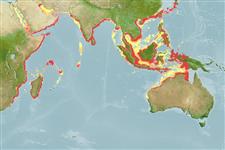Common names from other countries
Environment: milieu / climate zone / depth range / distribution range
Sinh thái học
Sống nổi và đáy; Thuộc về nước lợ; Mức độ sâu 0 - 55 m (Ref. 409). Tropical; 31°N - 32°S, 30°E - 138°E
Indo-West Pacific: Eastern Africa to Hong Kong and Australia.
Length at first maturity / Bộ gần gũi / Khối lượng (Trọng lượng) / Age
Maturity: Lm ? range ? - ? cm Max length : 3.2 cm BL con đực/không giới tính; (Ref. 409); 4.8 cm BL (female)
Rostrum, which has two dorsal denticles or teeth, is shorter than eyes. Elongated first 3 pereiopods and no fourth and fifth pereiopods. Larger female than males. Color: in life, whole body almost transparent. Milky or yellowish when dead.
Marketed either dried, boiled, salted, fermented, fresh, or processed in other ways; consumed locally in the form of seasoning (shrimp paste/sauce) (Ref. 409). Planktonic in life. Inhabits estuarine waters with mangroves (Ref. 374). Marine or brackish, but usually brackish and fished in the intertidal zone, estuaries (Ref. 409) and mangroves (Refs. 409, 121475). In general, it is a zooplanktivorous omnivore, wherein it primarily feeds on copepods, ostracods, other crustaceans, and molluscan veligers. It is observed to forage intensively after midnight (Ref. 104021). Omnivorous suspension feeder (Ref. 105380).
Life cycle and mating behavior
Chín muồi sinh dục | Sự tái sinh sản | Đẻ trứng | Các trứng | Sự sinh sản | Ấu trùng
Members of the order Decapoda are mostly gonochoric. Mating behavior: Precopulatory courtship ritual is common (through olfactory and tactile cues); usually indirect sperm transfer.
Pérez Farfante, I. and B. Kensley. 1997. (Ref. 75620)
IUCN Red List Status (Ref. 130435)
CITES status (Ref. 108899)
Not Evaluated
Not Evaluated
Human uses
Các nghề cá: Tính thương mại
FAO - Các nghề cá: landings | FishSource |
Các công cụ
Các nguồn internet
Estimates based on models
Preferred temperature
(Ref.
115969): 24.8 - 29.1, mean 28.3 (based on 1292 cells).
Thích nghi nhanh
Chiêù cao, thời gian nhân đôi của chủng quần tối thiểu là dưới 15 tháng (K=1.2).
